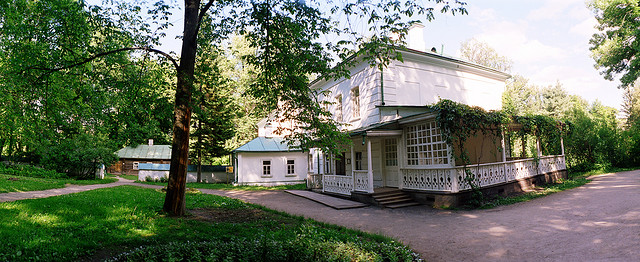

Location: 180 km (112 mi) South of Moscow, 12 km (7.5 mi) Southwest of Tula Map
Tel. 238 6710, 517 6081
Open: 10am- 5:30pm Wed- Sun
Entrance Fee: 100 rubles
Yasnaya Polyana (Ясная Поляна) or a Bright Glade is a former residence of one of the greatest Russian writers Leo Tolstoy. Yasnaya Polyana is situated 12 km (7.5 mi) Southwest of Tula in Tula Oblast in Russia. The original estate was constructed in the late 18th century and belonged to Volkonskiy family. Leo Tolstoy's mother, Maria Nikolayevna Volkonskaya, got married and kept the house as a dowry. Great Russian artist was born here in 1828. Here he also wrote many of his philosophical essays and novels including Anna Karenina, War and Peace and many others. However it wasn't here that he died in 1910. He left his house to look for a new beginning. Ironically he went for a new start in a female monastery where he obviously was turned back. He got sick and died in a simple room of the Astapovo train station. His modest unmarked grave is also located here. His country house was turned into museum soon after his death in June, 1921 so many of the items and interior are in its original place including his massive library that includes over 22,000 volumes.
Leo Tolstoy House Museum
Having moved to the
estate, L.N. Tolstoy expanded one of the outbuildings. The writer
lived in this house for over 50 years and created most of his works
there. Now the House is a museum of Leo Tolstoy.
The museum
was created by the decision of the All-Russian Central Executive
Committee on June 10, 1921 largely thanks to the efforts of A. L.
Tolstoy, daughter of Lev Nikolaevich. She and her brother Sergei
Lvovich were the first directors of the museum.
During the
Great Patriotic War, its exhibits were evacuated to Tomsk, and
Yasnaya Polyana itself was occupied for 45 days. When the Nazi
troops retreated, Tolstoy's house was set on fire, but the fire was
extinguished. By May 1942, the estate was reopened to visitors. In
the 1950s, large-scale restoration work was carried out.
The
exposition of the museum includes the original setting of the
estate, personal belongings of L. N. Tolstoy, his library (22,000
books). The atmosphere in the Leo Tolstoy house-museum has been left
the same as the writer himself left it, leaving Yasnaya Polyana
forever in 1910.
Since 2012, the director of the museum has
been Ekaterina Aleksandrovna Tolstaya, wife of V.I.Tolstoy,
great-great-grandson of L.N. Tolstoy.
Volkonsky House
Volkonsky's house is the oldest stone building in the estate.
Probably, the house was not built by Volkonsky, but appeared
earlier. Under the prince, in the central part of the house there
were workshops for the production of linen, carpets, and leather
processing. Under Tolstoy, servants lived here, there was a laundry
and a "black kitchen". The eastern wing of the Volkonsky House
housed the art workshop of Tolstoy's daughter Tatyana Lvovna.
Kuzminsky Wing
In this house in 1859-1862 there was a school
opened by Leo Tolstoy for peasant children. Then the guests stayed
in the outhouse, more often than those who stayed T.A.Kuzminskaya,
Lev Nikolaevich's sister-in-law.
Bath
In the 1890s, on the
Middle Pond in an English park, the writer built a bathhouse, which
in different years was either hammered out of planks or woven from
brushwood.
Mill
During Leo Tolstoy's lifetime, there was a
mill on the territory of the Yasnaya Polyana estate on the Voronka
River, which was used for household needs. Currently she is not.
Only the bridge, adapted for the installation of the mill, remains;
one of the parts of the mill (stone circle) lies on the shore.
Grave of Leo Tolstoy
In the last years of his
life, Tolstoy repeatedly made a request to bury him in the forest of
Stary Zakaz, on the edge of a ravine, in the "place of a green
stick." Tolstoy heard the legend about the green stick as a child
from his beloved brother Nikolai. When Nikolai was 12 years old, he
announced a great secret to the family. Once it is revealed, no one
else will die, there will be no wars and diseases, and people will
be “ant brothers”. All that remains is to find a green stick buried
at the edge of the ravine. The secret is written on it. The Tolstoy
children played at "ant brothers", sitting down under armchairs hung
with headscarves; sitting together in close quarters, they felt that
they felt good together “under one roof”, because they love each
other. And they dreamed of an "ant brotherhood" for all people. As
an old man, Tolstoy will write: “It was very, very good, and I thank
God that I could play it. We called it a game, and yet everything in
the world is a game, except for this. " Leo Tolstoy returned to the
idea of universal happiness and love in artistic creation, in
philosophical treatises, and in publicistic articles.
Tolstoy
recalls the story of the green stick in the first version of his
will: “So that no rituals should be performed when my body is buried
in the ground; a wooden coffin, and whoever wants to, will carry or
carry into the forest the Old Zakaz, opposite the ravine, to the
place of the green stick ”.
Leo Tolstoy Grave